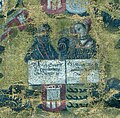Top Qs
Timeline
Chat
Perspective
County of Werdenberg
County of the Holy Roman Empire From Wikipedia, the free encyclopedia
Remove ads
Werdenberg was a county of the Holy Roman Empire, within the Duchy of Swabia, situated on either side of the Alpine Rhine, including parts of what is now St. Gallen (Switzerland), Liechtenstein, and Vorarlberg (Austria). It was partitioned from Montfort in 1230. In 1260, it was divided into Werdenberg and Sargans.
This article needs additional citations for verification. (December 2022) |


Remove ads
History
Summarize
Perspective
It is named for Werdenberg Castle, today located in the municipality of Grabs in the Swiss canton of St. Gallen, seat of the counts of Werdenberg (Werdenberger), The family was descended from count Hugo II of Tübingen (d. 1180), who married Elisabeth, daughter of the last count of Bregenz, thus inheriting substantial territory along the Alpine Rhine. His son was Hugo I of Montfort (d. 1228), whose son Rudolf I is considered the founder of the Werdenberg line. Rudolf's sons Hugo I of Werdenberg-Heiligenberg and Hartmann I of Werdenberg divided the southern territory of the Montfort inheritance, establishing the two lines of Werdenberg-Heiligenberg and Werdenberg-Sargans.
In 1308 Werdenberg was further divided into Werdenberg-Heiligenberg (Linzgau) and Werdenberg-Werdenberg. The Vaduz line of Counts of Werdenberg died out in 1406 and Vaduz passed to the Barons of Brandis.
The family fractured further into a number of cadet branches. The line of Werdenberg-Heiligenberg-Sigmaringen-Trochtelfingen remained influential in the early 16th century in the context of the Swabian League but was extinct in 1534.
The Werdenberg feud (Werdenbergfehde) was a major series of feuds between the Werdenberg and their neighbours in the late 15th century, most notably their conflict with the von Zimmern family of Swabia. The feud between the lords of Werdenberg and of Zimmern escalated in 1488, rising to an importance above merely regional concerns, influencing the imperial policy of Frederick III and Maximilian I regarding the formation of the Swabian League, the Imperial Reforms and the history of the Old Swiss Confederacy.
Remove ads
Counts of Werdenberg
Summarize
Perspective
Below, a list of the counts of Werdenberg,[1] numbered by order of ascension:
House of Tübingen
Partitions of Werdenberg under Tübingen rule
| County of Werdenberg (1230-1247) | ||||||
| County of Sargans (1st creation) (1247-1396) |
County of Vaduz (1322-1416) |
|||||
| County of Alpeck (1322-1383) |
County of Trochtelfingen (1332-1534) | |||||
| County of Werdenberg or Heiligenberg (1247-1402) |
County of Bludenz (1373-1394) |
County of Rheineck (1373-1395) | ||||
| Annexed to Ulm | ||||||
| Annexed to Austria | Pawned to the Counts of Toggenburg | |||||
| Pawned to the Counts of Montfort until 1485, then annexed by Switzerland | ||||||
| Passed to the Lords of Brandis | ||||||
| County of Sargans (2nd creation) (1436-1483) | ||||||
| Annexed by Switzerland | ||||||
| Divided between Fürstenberg and Austria (1534) and then Hohenzollern (1535) | ||||||
Table of rulers
(Note: Here the numbering of the counts is the same for all counties, as all were titled Counts of Werdenberg, despite the different parts of land or particular numbering of the rulers. The counts are numbered by the year of their succession.)
Successor houses in Werdenberg-Vaduz
(Note: Numbering restarts)
House of Brandis

- 1416-1456: Wolfhard, son-in-law of Albert III the Elder;
- 1456-1486: Ulrich;
- 1486-1507: Ludwig and Sigismund, brothers.
House of Sulz
- 1507-1535: Rudolf I, maternal grandson of Ulrich of Brandis;
- 1535-1556: John Louis;
- 1556-1569: William and Alwig, brothers;
- 1569-1572: Alwig;
- 1572-1611: Rudolf II;
- 1611-1613: John, sold Vaduz to the House of Hohenems.
House of Hohenems
- 1613-1640: Kaspar;
- 1640-1646: Jacob Hannibal;
- 1646-1662: Franz Wilhelm I;
- 1662-1686: Ferdinand Carl;
- 1686-1691: Jacob Hannibal Frederick and Franz Wilhelm II, brothers;
- 1691-1712: Jacob Hannibal Frederick, with Franz Wilhelm III (son of Franz Wilhelm I);
- 1712: To the Prince of Liechtenstein.
Remove ads
See also
Footnotes
References
External links
Wikiwand - on
Seamless Wikipedia browsing. On steroids.
Remove ads











